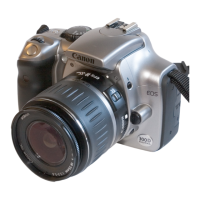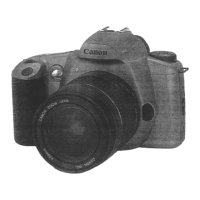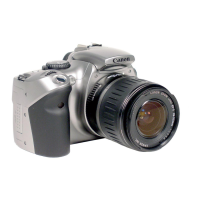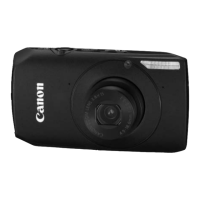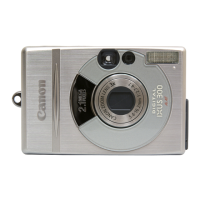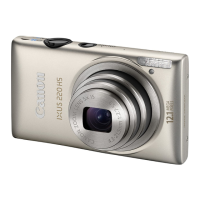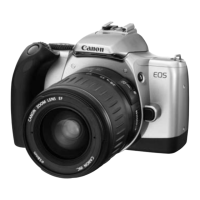Do you have a question about the Canon 300X and is the answer not in the manual?
Important initial checks and advice before operating the camera.
Explanation of icons, symbols, and page numbering conventions used.
Covers essential setup steps like installing batteries and loading film.
Detailed procedure for handling film in the camera.
Explanation of symbols and references used throughout the manual.
Important safety precautions for operating and handling the camera.
Advice on battery performance, LCD behavior, and contact care.
Identification of external camera body and lens components.
Identification of viewfinder elements and camera controls.
Instructions on how to attach the camera strap securely.
Detailed overview of icons and data shown on the LCD panel.
Explanation of information displayed within the camera's viewfinder.
Description of the Mode Dial, its zones, and available shooting modes.
Steps for installing CR2 lithium batteries into the camera.
How to check battery status and understand battery life.
Procedure for attaching and removing lenses from the camera body.
Explanation of the two-stage shutter press and its functions.
Techniques for holding the camera steady for sharp images.
Step-by-step guide to correctly loading film into the camera.
How the camera automatically rewinds film after the last shot.
Procedure for manually rewinding film mid-roll.
Introduction to automatic shooting modes for easy operation.
Steps for composing and shooting using the Full Auto mode.
How the AF-assist beam aids autofocus in low light.
Using specialized modes for portraits, landscapes, and close-ups.
Using modes for action, low-light portraits, and disabling flash.
How to activate and use the red-eye reduction feature.
Steps to configure and trigger the self-timer for delayed shots.
Using the optional remote controller for wireless shooting.
Attaching the eyepiece cover to prevent light leakage.
Choosing date format and setting the camera's date and time.
Procedure for setting the camera's date and time for imprinting.
Introduction to advanced shooting modes for greater creative control.
Explanation of the three available autofocus operation methods.
Methods for selecting the active autofocus point.
How to lock focus and recompose the shot.
Identifying difficult subjects and using manual focus.
Selecting how the film advances after each shot.
Understanding different exposure metering methods.
Steps for using Program AE for easy exposure control.
How to adjust shutter/aperture combinations while maintaining exposure.
How to set shutter speed and let the camera choose aperture.
How to set aperture and let the camera choose shutter speed.
How to manually control shutter speed, aperture, and use Bulb mode.
Achieving wide depth of field for group and landscape shots.
How to make pictures lighter or darker than standard exposure.
How to capture multiple exposures with varying exposures automatically.
How to lock exposure settings on a specific subject or area.
How to take multiple shots on a single film frame.
Using the button to check the depth of field.
Manually setting ISO and configuring beeper notification options.
Preventing accidental shots without film or lens.
Automatic and manual flash operation in different shooting modes.
Setting flash sync speed and understanding flash distance.
How to lock flash exposure for specific subjects.
Adjusting the self-timer delay duration.
Details on AF point selection, AF-assist beam, sync, and flash speed settings.
Summary of feature availability across different shooting modes.
Common problems and their solutions for camera operation.
Details on camera type, media, compatible lenses, and viewfinder.
Specifications for AF system, metering, and exposure controls.
Details on shutter, flash, film transport, custom functions, and power.
FCC compliance and legal notices regarding device operation.
Important initial checks and advice before operating the camera.
Explanation of icons, symbols, and page numbering conventions used.
Covers essential setup steps like installing batteries and loading film.
Detailed procedure for handling film in the camera.
Explanation of symbols and references used throughout the manual.
Important safety precautions for operating and handling the camera.
Advice on battery performance, LCD behavior, and contact care.
Identification of external camera body and lens components.
Identification of viewfinder elements and camera controls.
Instructions on how to attach the camera strap securely.
Detailed overview of icons and data shown on the LCD panel.
Explanation of information displayed within the camera's viewfinder.
Description of the Mode Dial, its zones, and available shooting modes.
Steps for installing CR2 lithium batteries into the camera.
How to check battery status and understand battery life.
Procedure for attaching and removing lenses from the camera body.
Explanation of the two-stage shutter press and its functions.
Techniques for holding the camera steady for sharp images.
Step-by-step guide to correctly loading film into the camera.
How the camera automatically rewinds film after the last shot.
Procedure for manually rewinding film mid-roll.
Introduction to automatic shooting modes for easy operation.
Steps for composing and shooting using the Full Auto mode.
How the AF-assist beam aids autofocus in low light.
Using specialized modes for portraits, landscapes, and close-ups.
Using modes for action, low-light portraits, and disabling flash.
How to activate and use the red-eye reduction feature.
Steps to configure and trigger the self-timer for delayed shots.
Using the optional remote controller for wireless shooting.
Attaching the eyepiece cover to prevent light leakage.
Choosing date format and setting the camera's date and time.
Procedure for setting the camera's date and time for imprinting.
Introduction to advanced shooting modes for greater creative control.
Explanation of the three available autofocus operation methods.
Methods for selecting the active autofocus point.
How to lock focus and recompose the shot.
Identifying difficult subjects and using manual focus.
Selecting how the film advances after each shot.
Understanding different exposure metering methods.
Steps for using Program AE for easy exposure control.
How to adjust shutter/aperture combinations while maintaining exposure.
How to set shutter speed and let the camera choose aperture.
How to set aperture and let the camera choose shutter speed.
How to manually control shutter speed, aperture, and use Bulb mode.
Achieving wide depth of field for group and landscape shots.
How to make pictures lighter or darker than standard exposure.
How to capture multiple exposures with varying exposures automatically.
How to lock exposure settings on a specific subject or area.
How to take multiple shots on a single film frame.
Using the button to check the depth of field.
Manually setting ISO and configuring beeper notification options.
Preventing accidental shots without film or lens.
Automatic and manual flash operation in different shooting modes.
Setting flash sync speed and understanding flash distance.
How to lock flash exposure for specific subjects.
Adjusting the self-timer delay duration.
Details on AF point selection, AF-assist beam, sync, and flash speed settings.
Summary of feature availability across different shooting modes.
Common problems and their solutions for camera operation.
Details on camera type, media, compatible lenses, and viewfinder.
Specifications for AF system, metering, and exposure controls.
Details on shutter, flash, film transport, custom functions, and power.
FCC compliance and legal notices regarding device operation.
| Type | Digital Camera |
|---|---|
| Model | PowerShot 300X |
| Sensor Type | CCD |
| ISO Sensitivity | 100 |
| Shutter Speed | 15 |

